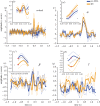Evidence for parallel activation of the pre-supplementary motor area and inferior frontal cortex during response inhibition: a combined MEG and TMS study
- PMID: 29515852
- PMCID: PMC5830741
- DOI: 10.1098/rsos.171369
Evidence for parallel activation of the pre-supplementary motor area and inferior frontal cortex during response inhibition: a combined MEG and TMS study
Abstract
This pre-registered experiment sought to uncover the temporal relationship between the inferior frontal cortex (IFC) and the pre-supplementary motor area (pre-SMA) during stopping of an ongoing action. Both regions have previously been highlighted as being central to cognitive control of actions, particularly response inhibition. Here we tested which area is activated first during the stopping process using magnetoencephalography, before assessing the relative chronometry of each region using functionally localized transcranial magnetic stimulation. Both lines of evidence pointed towards simultaneous activity across both regions, suggesting that parallel, mutually interdependent processing may form the cortical basis of stopping. Additional exploratory analysis, however, provided weak evidence in support of previous suggestions that the pre-SMA may provide an ongoing drive of activity to the IFC.
Keywords: inferior frontal cortex; magnetoencephalography; pre-supplementary motor area; response inhibition; timing; transcranial magnetic stimulation.
Conflict of interest statement
C.D.C. is a member of the Royal Society Open Science editorial board but had no involvement in the peer review process of this submission.
Figures





Similar articles
-
Action-related dynamic changes in inferior frontal cortex effective connectivity: A TMS/EEG coregistration study.Cortex. 2018 Nov;108:193-209. doi: 10.1016/j.cortex.2018.08.004. Epub 2018 Aug 27. Cortex. 2018. PMID: 30245305
-
Dissociating the Role of the pre-SMA in Response Inhibition and Switching: A Combined Online and Offline TMS Approach.Front Hum Neurosci. 2013 Apr 18;7:150. doi: 10.3389/fnhum.2013.00150. eCollection 2013. Front Hum Neurosci. 2013. PMID: 23616761 Free PMC article.
-
Stimulation of the Dorsal Premotor Cortex, But Not of the Supplementary Motor Area Proper, Impairs the Stop Function in a STOP Signal Task.Neuroscience. 2018 Dec 1;394:14-22. doi: 10.1016/j.neuroscience.2018.10.005. Epub 2018 Oct 18. Neuroscience. 2018. PMID: 30342203
-
Neuromagnetic integrated methods tracking human brain mechanisms of sensorimotor areas 'plastic' reorganisation.Brain Res Brain Res Rev. 2000 Sep;33(2-3):131-54. doi: 10.1016/s0169-328x(00)00090-5. Brain Res Brain Res Rev. 2000. PMID: 11011062 Review.
-
Inhibition and impulsivity: behavioral and neural basis of response control.Prog Neurobiol. 2013 Sep;108:44-79. doi: 10.1016/j.pneurobio.2013.06.005. Epub 2013 Jul 13. Prog Neurobiol. 2013. PMID: 23856628 Review.
Cited by
-
Exploring stop signal reaction time over two sessions of the anticipatory response inhibition task.Exp Brain Res. 2022 Nov;240(11):3061-3072. doi: 10.1007/s00221-022-06480-x. Epub 2022 Oct 14. Exp Brain Res. 2022. PMID: 36239740 Free PMC article.
-
Secondary motor areas for response inhibition: an epicortical recording and stimulation study.Brain Commun. 2022 Aug 4;4(4):fcac204. doi: 10.1093/braincomms/fcac204. eCollection 2022. Brain Commun. 2022. PMID: 35982946 Free PMC article.
-
The Effect of Coil Orientation on the Stimulation of the Pre-Supplementary Motor Area: A Combined TMS and EEG Study.Brain Sci. 2022 Oct 6;12(10):1358. doi: 10.3390/brainsci12101358. Brain Sci. 2022. PMID: 36291292 Free PMC article.
-
No effects of 1 Hz offline TMS on performance in the stop-signal game.Sci Rep. 2023 Jul 18;13(1):11565. doi: 10.1038/s41598-023-38841-z. Sci Rep. 2023. PMID: 37463991 Free PMC article.
-
Paradoxical response inhibition advantages in adolescent obsessive compulsive disorder result from the interplay of automatic and controlled processes.Neuroimage Clin. 2019;23:101893. doi: 10.1016/j.nicl.2019.101893. Epub 2019 Jun 8. Neuroimage Clin. 2019. PMID: 31220759 Free PMC article.
References
-
- Aron AR, Poldrack RA. 2006. Cortical and subcortical contributions to stop signal response inhibition: role of the subthalamic nucleus. J. Neurosci. 26, 2424–2433. (doi:10.1523/Jneurosci.4682-05.2006) - DOI - PMC - PubMed
-
- Aron AR, Robbins TW, Poldrack RA. 2014. Inhibition and the right inferior frontal cortex: one decade on. Trends Cogn. Sci. 18, 177–185. (doi:10.1016/j.tics.2013.12.003) - DOI - PubMed
-
- Verbruggen F, Logan GD. 2008. Response inhibition in the stop-signal paradigm. Trends Cogn. Sci. 12, 418–424. (doi:10.1016/j.tics.2008.07.005) - DOI - PMC - PubMed
-
- Swann NC, Cai WD, Conner CR, Pieters TA, Claffey MP, George JS, Aron AR, Tandon N. 2012. Roles for the pre-supplementary motor area and the right inferior frontal gyrus in stopping action: electrophysiological responses and functional and structural connectivity. Neuroimage 59, 2860–2870. (doi:10.1016/j.neuroimage.2011.09.049) - DOI - PMC - PubMed
-
- Rae CL, Hughes LE, Anderson MC, Rowe JB. 2015. The prefrontal cortex achieves inhibitory control by facilitating subcortical motor pathway connectivity. J. Neurosci. 35, 786–794. (doi:10.1523/JNEUROSCI.3093-13.2015) - DOI - PMC - PubMed
Grants and funding
LinkOut - more resources
Full Text Sources
Other Literature Sources

